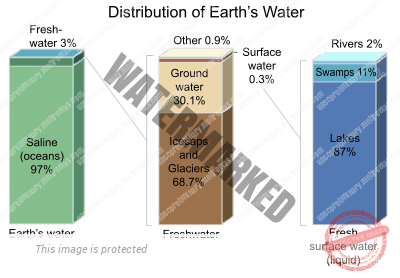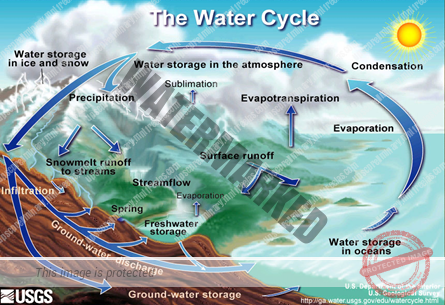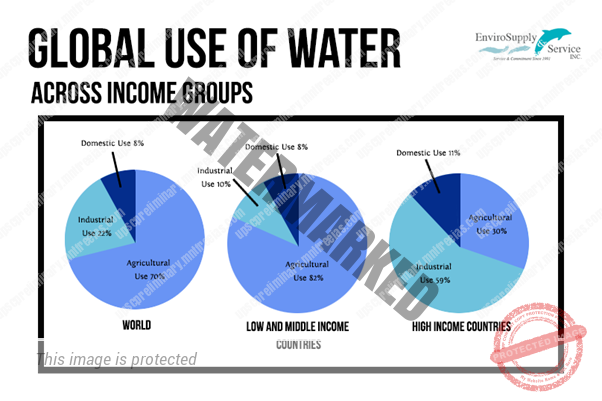- CHANGES IN LAND AND RESOURCE USE:
- WATER RESOURCE
- WATER AS A RESOURCE
- RESOURCE DISTRIBUTION OF WATER
- WATER RESOURCE IN INDIA
- GROUND WATER
UNIT 3 – RESOURCES AND ITS UTILIZATION – PART 2
CHANGES IN LAND AND RESOURCE USE:
During the last 100 years, a better health care delivery system and an improved nutritional status has led to rapid population growth, especially in the developing countries. This phenomenal rise in human numbers has, in the recent past, placed great demands on the earth’s natural resources.
Large stretches of land such as forests, grasslands and wetlands have been converted into intensive agriculture. Land has been taken for industry and the urban sectors. These changes have brought about dramatic alterations in land-use patterns and rapid disappearance of valuable natural eco- systems.
The need for more water, more food, more energy, more consumer goods, is not only the result of a greater population, but also the result of overutilization of resources by people from the more affluent societies, and the affluent sections of our own.
Industrial Development is aimed at meeting growing demands for all consumer items. However, these consumer goods also Generate Waste in ever larger quantities. The growth of industrial complexes has led to a shift of people from their traditional, sustainable, rural way of life to urban centres that developed around industry.
This has increased the disparity between what the surrounding land can produce and what the large number of increasingly consumer oriented people in these areas of high population density consume.
Urban Centres cannot exist without the resources from the rural and other resources from forests. Rural agricultural systems are dependent on Forests, Wetlands, Grasslands, Rivers And Lakes. The result is a movement of natural resources from the wilderness ecosystems and agricultural sector to the urban user.
The magnitude of the shift of resources has been increasing in parallel with the growth of industry and urbanisation, and has changed natural landscapes all over the world thereby also resulting in huge economic and cultural disparities across various populations.
WATER RESOURCE
WATER AS A RESOURCE :
Water is necessity for survival of life on earth. About 70% of Earth (often called as Blue Planet) is covered with water and as far as we know, it is the only planet in our solar system containing liquid water.
Only 2.5% Of Water on the Earth Is Fresh Water, and over two thirds of this is frozen in glaciers and polar ice caps. Water is virtually required for every human activity and natural phenomena. But however, Water demand already exceeds supply in many parts of the world, and many more areas are expected to experience this imbalance in the near future. Climate change will have significant impacts on water resources around the world because of the close connections between the climate and hydrologic cycle.
Due to the expanding human population competition for water is growing such that many of the world’s major aquifers are becoming depleted. Many pollutants threaten water supplies, but the most widespread, especially in underdeveloped countries, is the discharge of raw sewage into natural waters.
RESOURCE DISTRIBUTION OF WATER
The distribution of water on the Earth’s surface is extremely uneven. Only 3% of water on the surface is fresh; the remaining 97% resides in the ocean. Of freshwater, 69% resides in glaciers, 30% underground, and less than 1% is located in lakes, rivers, and swamps. Looked at another way, only 1% of the water on the Earth’s surface is usable by humans, and 99% of the usable quantity is situated underground.
A storage location for water such as an ocean, glacier, pond, or even the atmosphere is known as a Reservoir. A water molecule may pass through a reservoir very quickly or may remain for much longer. The amount of time a molecule stays in a reservoir is known as Its Residence Time.
Water is present in 3 states on the planet, because of the ranges in temperature in specific locations around the planet; all three phases may be present in a single location or in a region.
The three phases are Solid (Ice Or Snow), Liquid (Water), And Gas (Water Vapor).
THE HYDROLOGICAL CYCLE
The energy of the sun is converted to heat, removing water from wet surfaces by evaporation and from the leaves of plants by transpiration. The combination of both processes is called evapotranspiration. The resulting water vapour is transmitted by moving air and condenses to return to the earth as precipitation.
Over the oceans, evaporation is more than precipitation, over the earth, precipitation is more than evaporation. Rain reaches the ground and flows over its surfaces as streams, lakes, and surfaces runoff. Another portion of water infiltrates into the soil to form the groundwater resources. The difference between precipitation and evaporation is balanced by the water that is returned to the oceans by runoff and groundwater flow.
WATER RESOURCES IN INDIA
India is a large country and sustains about 17% of the world population, which makes it the second most populated nation in the world. As per an estimate by Ministry of Water Resources, India has 2.5% (328.7 mha) of global land mass and 4% of world fresh water resources. About 50% of the annual precipitation takes place in just about 15 .
There are huge spatial and temporal variations in the rainfall pattern. India’s freshwater resources comprise the single most important natural endowment and has very important role in its economy and human settlements. The freshwater resources of India are mainly comprised of River Systems, Groundwater And Wetlands.
RAINFALL
The rainfall variation is so huge that Mousinram near Cherrapunji in Meghalaya in the North-East receives about 11,690 mm rainfall while Jaisalmer in Rajasthan has only 150 mm of rainfall. About 75% of the rainfall is received in rainy season (June to September).
As per an estimate around 21% of the area in the country receives less than 750 mm of rains annually while 15% has rainfall in excess of 1500 mm. Peninsular India receives rainfall less than 600 mm while western part of Rajasthan and Gujarat experience a rainfall less than 500 mm annually.
SURFACE WATER RESOURCES– are comprised of rivers and inland resources like lakes, ponds, canals etc. A large section of society is dependent on them as they provide livelihood and other ecosystem services. Of many rivers in India, 12 are classified as major rivers having total catchment area of about 252 Mha. The Ganga – Brahmaputra – Meghna system is having the largest catchment area of 110 Mha (CWC, 2010). Other major rivers are- Indus, Godavari, Krishna and Mahanadi with a total catchment area of about 103 Mha. The catchment area of medium rivers is about 25 Mha.
GROUND WATER
India is one of the largest ground water consumers of the world with an estimated usage of 230 km3 per year (World Bank, 2010a). About 60% of the water demand in agriculture and 80% in domestic usage are met through groundwater.
The National Sample Surveys (NSS) using remote sensing data suggest that as much as 75 to 80 % of the country’s irrigated area is served by groundwater wells (Shah, 2009).



